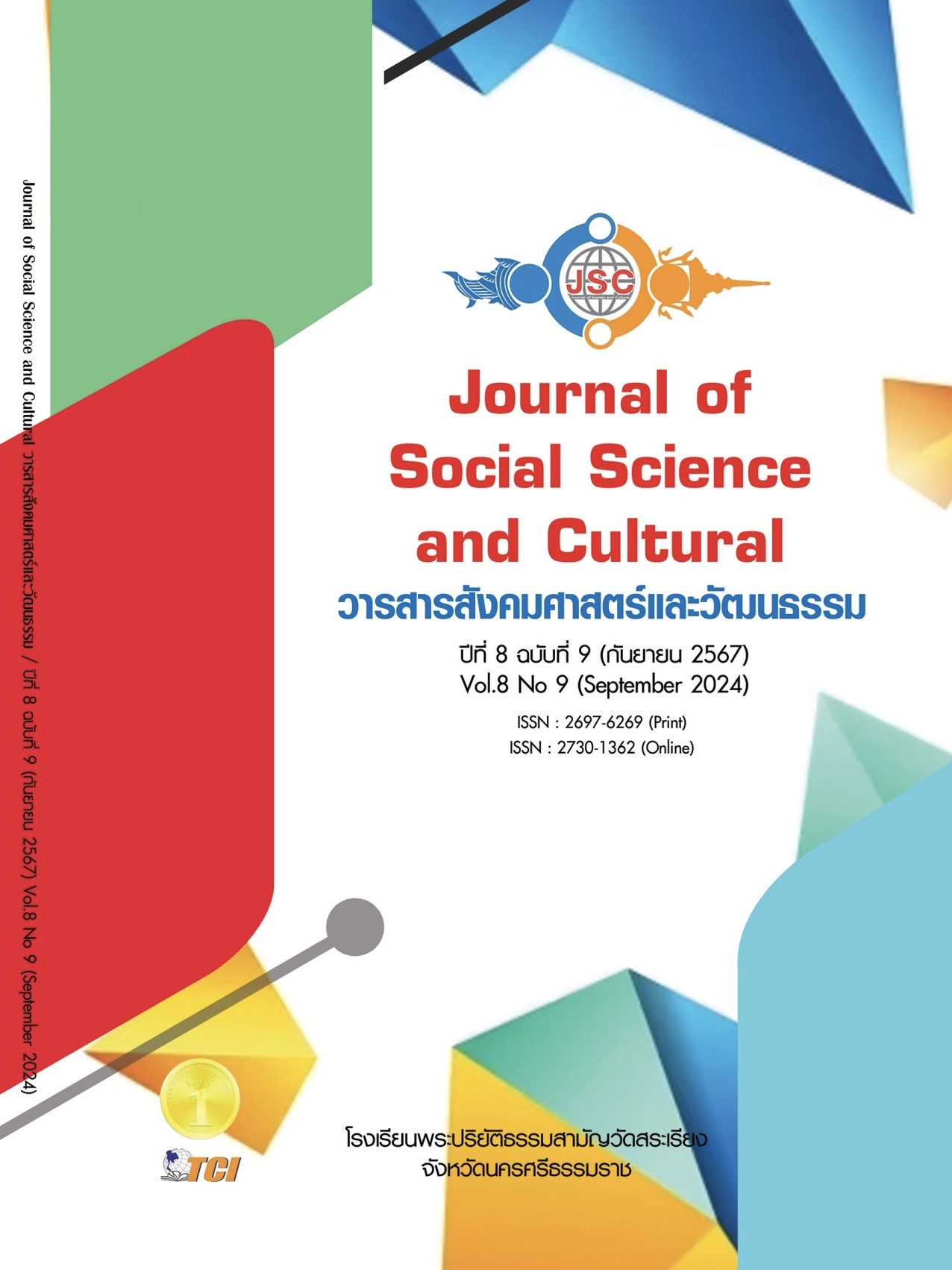THE DEVELOPMENT OF VOCATIONAL TEACHING AND LEARNING MANAGEMENT MODEL BY INTEGRATING LEARNING PROCESS WITH STEM EDUCATION
Main Article Content
Abstract
The objectives of this research were to: 1) Study the problems and needs in vocational teaching and learning management by integrating learning process with STEM education, 2) Develop and evaluate the appropriateness of the vocational teaching and learning management model by integrating learning process with STEM education, and 3) Develop and evaluate the efficiency of the training course for the vocational teaching and learning management model by integrating learning process with STEM education. The sample group consisted of 400 staffs of administrative team by simple random sampling heads of the curriculum and teaching development center, and teachers in vocational colleges. The research statistics included percentage, mean, SD, and PNI modified to arrange the needs. The results showed that: 1) The conditions and problems of vocational learning management were at a moderate level, with the need for the learning management model at a high level. The highest aspect of the design for the problem solution, followed by defining the problems, testing and evaluation and task solution, proposing the solutions with the expected results, planning and implementation of the solutions, and idea data collection related to the problem solution. 2) The vocational teaching and learning management model by integrating the learning process with STEM Education consisted of 6 steps, i.e., teacher preparation process, STEM teacher development, selecting an appropriate teaching method, designing learning activities, setting learning conditions, and preparing evaluation process. The results of the appropriateness evaluation showed that the model was at a high level. 3) The developed training course reached an efficiency of 83.81/80.75 with the practical part of 82.61%. Finally, the users’ satisfaction was high, while the product evaluation reached a very high level overall.
Article Details
References
จิดาภา ชูสังข์. (2566). การพัฒนารูปแบบการบริหารงานวิชาการ โดยบูรณาการแนวคิดจิตตปัญญาศึกษาและวงจรบริหารงานคุณภาพในสถานศึกษาอาชีวศึกษา. วารสารมนุษยศาสตร์และสังคมศาสตร์ มหาวิทยาลัยธนบุรี, 17(3), 44-59.
ธีระชัย เอี่ยมผ่อง. (2561). การพัฒนากิจกรรมการเรียนรู้โดยใช้ปัญหาเป็นฐานตามแนวทางสะเต็มศึกษา เรื่อง การประยุกต์การแปลงทางเรขาคณิต สำหรับนักเรียนชั้นมัธยมศึกษาปีที่ 2. วารสารการศึกษาและนวัตกรรม, 23(1), 67-177.
บุญชม ศรีสะอาด. (2554). การวิจัยทางการวัดผลและประเมินผล. (พิมพ์ครั้งที่ 9). กรุงเทพมหานคร: สุวีริยาสาส์น.
ปริษฐา ถนอมเวช. (2563). การพัฒนาหลักสูตรฝึกอบรมงานพิมพ์หนังสือราชการภายในของครูโดยใช้รูปแบบซิป. วารสารครุศาสตรอุตสาหกรรม, 19(2), 12-19.
พิสิฐ เมธาภัทร และคณะ. (2532). ยุทธวิธีการเรียนการสอนวิชาเทคนิค. กรุงเทพมหานคร: โรงพิมพ์มหาวิทยาลัยเทคโนโลยีพระจอมเกล้าพระนครเหนือ.
มานิตย์ จันสุทธิรางกูร. (2563). หนังสือเรียนรายวิชาพื้นฐานวิทยาศาสตร์และเทคโนโลยี ชั้นประถมศึกษาปีที่ 1 ตามมาตรฐานการเรียนรู้และตัวชี้วัด กลุ่มสาระการเรียนรู้วิทยาศาสตร์และเทคโนโลยี (ฉบับปรับปรุง พ.ศ.2560) ตามหลักสูตรแกนกลางการศึกษาขั้นพื้นฐาน พุทธศักราช. กรุงเทพมหานคร: อิมเมจิเนียริ่ง เอ็ดดูเคชั่น.
มูลนิธิคีนันแห่งเอเชีย. (2566). โครงการเชฟรอน “Enjoy Science: สนุกวิทย์ พลังคิด เพื่ออนาคต”. เรียกใช้เมื่อ 26 มกราคม 2566 จาก http://www.kenan-asia.org/th/key-challenges-th/21st-century-skills-th/enjoy-science/
วัชระ ประทุมรัตน์ และอินทิรา รอบรู้. (2562). การสังเคราะห์งานวิจัยที่เกี่ยวข้องกับการจัดการเรียนรู้แบบสะเต็มศึกษา. วารสารครุสีมา, 2(2), 41-49.
ศิริชัย กาญจนวาสี. (2554). ทฤษฎีการประเมิน. (พิมพ์ครั้งที่ 8). กรุงเทพมหานคร: โรงพิมพ์แห่งจุฬาลงกรณ์มหาวิทยาลัย.
สงัด อุทรานันท์. (2530). ทฤษฎีหลักสูตร. กรุงเทพมหานคร: โรงพิมพ์สยาม.
สำนักงานคณะกรรมการการอาชีวศึกษา. (2566). ข้อมูลสถานศึกษาอาชีวศึกษาภาคเอกชน. เรียกใช้เมื่อ 13 มิถุนายน 2566 จาก https://vecp.vec.go.th/Portals/68/Doc/School/Private%20Vocational%20School%202566.pdf?ver=2567-02-14-104355-223
สำนักงานเลขาธิการสภาการศึกษา. (2559). สะเต็มศึกษา: วิทยาศาสตร์ เทคโนโลยี วิศวกรรมศาสตร์ และคณิตศาสตร์. กรุงเทพมหานคร: พริกหวาน กราฟฟิก.
สุวิธิดา จรุงเกียรติกุล. (2566). ทักษะการเรียนรู้ในศตวรรษที่ 21. เรียกใช้เมื่อ 26 มกราคม 2566 จาก http://www.trueplookpanya.com/education/content/66054
สุวิมล ว่องวาณิช. (2550). การวิจัยประเมินความต้องการจำเป็น. กรุงเทพมหานคร: จุฬาลงกรณ์มหาวิทยาลัย.
โสภณ มโนมะยา. (2562). รูปแบบการพัฒนาครูด้วยแนวคิดจิตตปัญญาศึกษา. ใน ดุษฎีนิพนธ์ปรัชญาดุษฎีบัณฑิต สาขาวิชาทางสังคมศาสตร์. มหาวิทยาลัยรามคำแหง.
Cochran. W. G. (1997). Sampling techniques. Hoboken, NJ: John Wiley & Sons, Inc.
Krejcie, R. V. & Morgan, D. W. (1970). Determining Sample Size for Research Activities. Educational and Psychological Measurement, 30(3), 607-610.
Likert, R. (1967). A Technique for the Measurement of Attitude. Chicago: Rand me Nally Company.
Lincharern, A. (2012). Qualitive data analysis techniques. Journal of Educational Measurement Mahasarakham University, 17(1), 17-29.
Stufflebeam, D. L. et al. (1971). Educational Evaluation and Decision Making. Itasca Illinois: Peacock Publisher Inc.
Taba, H. (1970). Curriculum Development; Theory and Practice. New York: Harcourt, Brance & World.
Tyler, R. W. (1975). Basic Principles of Curriculum and Instruction. Chicago: University of Chicago Press.
Zhbanova, K. (2019). Editorial: developing creativity through STEM subjects integrated with the Arts. Journal of STEM Arts. Crafts and Constructions, 4(1), 1-15.


